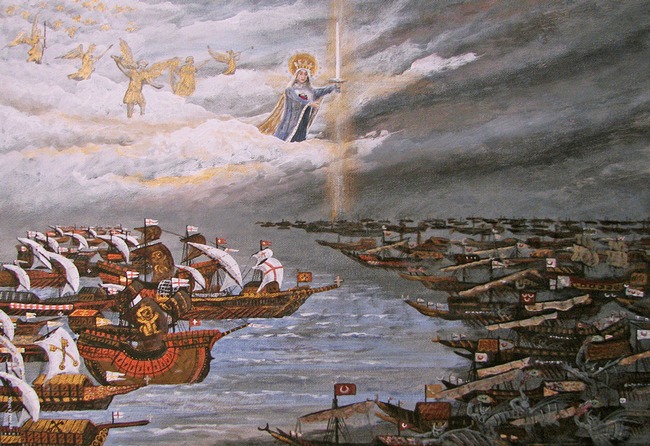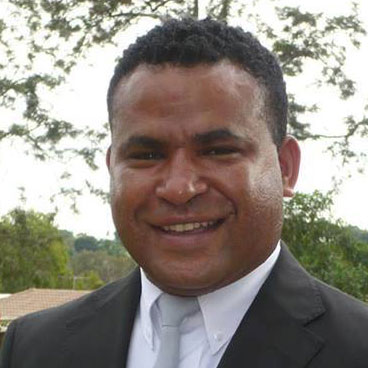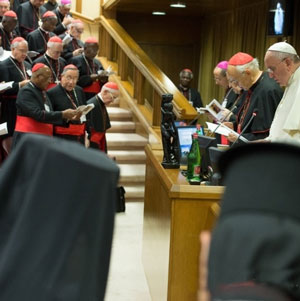On Friday I was privileged to assist with a nine-day novena organised by the Legion of Mary.
The novena, which prayed for world peace and deliverance from the ISIS scourge, concluded with a Mass and Holy Hour celebrating the Feast of Our Lady of the Rosary. This feast commemorates the Battle of Lepanto, wherein a Western alliance initiated by Pope St Pius V repelled an Ottoman invasion of Europe.
Here’s my sermon, which is really an historical survey of that great victory:
The Defence of Malta — 1565
Soleiman the Magnificent was the greatest sultan in Ottoman history. He reigned for 50 years, and he expanded the Empire’s borders in every direction. His greatest dream was to conquer Rome. Then history would truly judge him as an equal to Caesar. Moreover, the conquest of Rome would permit St Peter’s Basilica, then under construction, to be converted into a great mosque – just as Constantinople’s Hagia Sophia had been converted a century earlier.
It was the dream of Roman conquest which caused Soleiman to turn his attention to the island of Malta in 1565. From the harbours of Malta, the Ottomans could bombard the western coast of the Italian peninsula, Rome included. By 1565, however, Soleiman was an old man. He recused himself from battle, but sent, in his stead, an army of 45,000.
Malta fielded an army of 6,000 to defend the small island. The rest of Europe looked on, presuming that Malta would fall as Rhodes had, at similar scale, decades earlier. On the eve of battle, 700 Knights of Malta assembled in their chapel. They each made a good confession, and assisted at the Holy Sacrifice of Mass. Afterwards, the Grand Master addressed his men:
“A formidable army composed of audacious barbarians is descending on this island. These persons, my brothers, are the enemies of Jesus Christ. Today it is a question of the defence of our Faith. Are the Gospels to be superseded by the Koran? God on this occasion demands of us our lives, already vowed to His service. Happy will be those who first consummate this sacrifice.”
Many of the knights did just that, laying down their lives. Nonetheless, during the four month seige, Malta’s small army of 6,000 withstood the Ottoman barrage. Three quarters of the Ottoman forces were killed during the assault, and eventually the Turks returned home, defeated and exhausted.
Land invasion — 1566
Soleiman was furious. “I see that it is only in my own hand that my sword is invincible!” Twelve months later, he assembled a massive army of 300,000 soldiers, and marched them towards Vienna. He would take Rome by land, using one of the largest armies assembled since Antiquity.
When the Count of Szigetvar, a Hungarian fortress east of Vienna, led a successful raid on Ottoman supply trains, Soleiman wheeled his massive army around. Szigetvar, he declared, would be wiped off the map.
For nearly a month, wave after wave of Turkish infantry were thrown back from the walls. Soleiman tried to bribe the Count. He could be puppet king of Croatia, if he would yield his city. The Count refused: “No one shall point his finger on my children in contempt.”
Eventually, the Ottoman artillery breached the fortress walls. The Count assembled his last 600 men and, holding up his sword, he rallied them:
“With this sword I earned my first honour and glory. I want to appear with it once more before the eternal throne to hear my judgement.”
He charged his men into battle, and the small band was quickly swamped by superior numbers. Soleiman, however, did not live to see the final battle. He had died four days previously, of dysentry. His soldiers, furious at the losses they sustained, and grieving their sultan, slaughtered the civilian population and razed the city to the ground. But the Ottoman army was exhausted, and turned home. Although the city of Szigetvar was eliminated, it had saved Europe.
The conquest of Cyprus — 1570
Soleiman’s heir, Selim II, was cruel and barbaric. The new sultan invaded Cyprus in 1570. Although the garrison of 500 surrendered on terms, when the city gates were opened, the Ottomans rushed in and slaughtered them. Then they set on the civilian population, massacring twenty thousand adults. The children who survived were shipped to Constantinople and sold at the slave markets.
But in 1566, God had raised up one of the Church’s greatest popes. Pope St Pius V solemnly declared:
“I am taking up arms against the Turks, but the only thing that can help me is the prayers of priests of pure life.”
The state of the Church in 1570 is comparable to the Church of today. Corruption and laxity were rife. But then, as now, a cohort of holy and virtuous clergy endured. Their prayers sustained the pope in his negotiations, and in 1571 he formed ‘the Holy League’ — an alliance of Christian kingdoms and city states which set aside rivalries and jealousies to join forces against the Ottoman threat.
To their shame, France and England excused themselves. (Perhaps this is why Lepanto is not so well-known in the English-speaking world.) Both kingdoms, in fact, furnished assistance to the Ottomans, for tawdry political and economic gain.
Selim’s forces, meanwhile, performed atrocities which are comparable to the modern day efforts of ISIS. In 1571, still in Cyprus, the Ottomans again violated terms of surrender, and enslaved men who had laid down arms. A commander was cruelly and horrifically tortured — his nose and ears cut off, and his bleeding wounds cauterised by hot irons. He was bridled before his men and terrified civilians, and dragged around camp on his hands and knees. He was strung up for many hours, and skinned alive.
It is a mistake to think the scourge of ISIS is without precedent. History is full of cruel horror and sinister evil. Just as the challenges are similar, so are the remedies. The Holy Rosary has saved the Church before. It can do so again.
The battle of Lepanto — 1571
Pius V had granted a plenary indulgence to the soldiers and crews of the Holy League. Priests of the great orders — Franciscans, Dominicans, Jesuits — were aboard the Holy League’s ships, offering Mass and hearing confessions. Every man was assigned standard weaponry, and also something non-standard — a weapon more powerful than anything the Ottomans possessed: the Holy Rosary.
On the eve of battle, the Holy League’s soldiers knelt on the decks of their ships and prayed the Rosary. Back in Rome, and all over Christendom, the lay faithful responded to the pope’s request, and filling their local churches, they too prayed the Rosary.
At dawn on 7 October 1571, the Holy League’s fleet sailed east, against the wind. Perhaps by coincidence, perhaps by design, the four navies assumed a cruciform. The massive Ottoman fleet sailed west to meet them. Again, perhaps by coincidence, perhaps by design, the Turkish forces assumed a huge crescent.
As the fleets grew closer, the Christians could hear the gongs and cymbals of the Ottomans. The soldiers stood on deck, silently praying. Priests held large crucifixes, walking up and down deck, exhorting courage and hearing last confessions.
The forces met at midday — the hour of the Angelus. The hour of the Incarnation. Perhaps all those rosaries, and the intercessory prayers of our Lady herself, had something to do with the wind. It changed suddenly. Abruptly. Radically. The wind turned 180 degrees, filling the sails of the Holy League, and causing disarray among the Ottomans.
Battle ensued for 5 hours. At first, the outnumbered Holy League and massive Ottoman force fought as though evenly matched. One soldier of the Holy League, driven to despair, took his sword to the ship’s crucifix. The blade instantly shattered. Years later, the sword was re-forged, but when the new blade was pulled from the fire, it too fell to pieces.
The crucifix aboard the main ship twisted itself to avoid a Turkish cannonball. It is now displayed and venerated in Barcelona’s cathedral.
Another of the ships carried aboard a unique gift from the king of Spain: a rare image of our Lady. Exactly forty years before the battle of Lepanto, the Blessed Virgin appeared to a peasant boy, leaving a miraculous image of herself on his smock. The bishop of the region commissioned an artist to paint five copies of the image, and he touched each image to the original. Our Lady of Guadalupe was present at Lepanto.
Eventually the battle turned in the Holy League’s favour, and then a rout ensued. Thirty thousand Ottomans perished. Not until the First World War would the world again witness such carnage in a single day’s fighting.
In the days that followed, news of the victory made its way back to Rome. But Rome knew already. On the day of the battle, St Pius had been consulting with his cardinals when he paused and peered out a window. He was favoured with a supernatural vision which he then related to the cardinals present:
“Let us set aside business and fall on our knees in thanksgiving to God, for he has given our fleet a great victory.”
Lessons for us
The courage and fortitude of our forebears should inspire us. The men and women in Malta, in Hungary, and at Lepanto are owed our remembrance and gratitude. But we can also imitate them, and engage in our own battles against sin and evil with equal fervour. We should fear sin more than death itself. We should rather die than offend God and goodness.
Let’s resolve, too, to renew our spirit of prayer, and devotion to our Blessed Mother. She told the children at Fatima that the Rosary has the power to save the world. The world had learned that previously, at Lepanto. But the world too easily forgets. Let’s not forget again.
Holy Mary, Help of Christians, Lady of the Rosary, pray for us.






Pius V was one of the best. A “Great” if ever there was.
Malta was a stronghold in the second world war too. Tough bastards they are.
What an irony, this article! And now, Salvini has just been condemned by the Catholic Vatican for invoking Mary to Italy. Same enemy of the Christians, only this time using mass migration as a weapon of choice: https://www.lifesitenews.com/news/vatican-leaders-outraged-as-anti-immigration-politician-commends-italy-to-mary